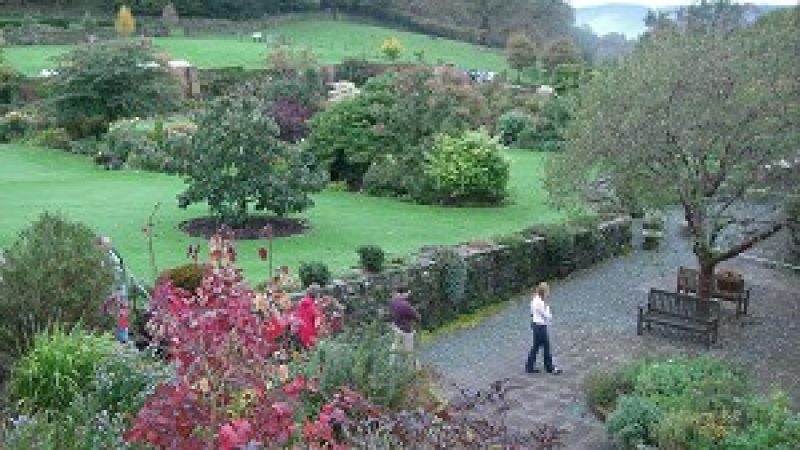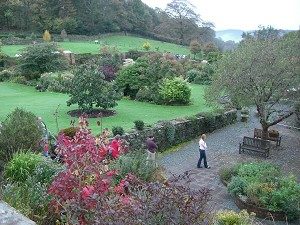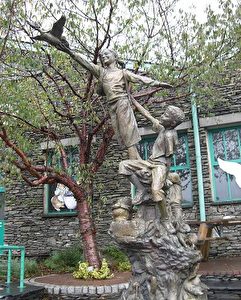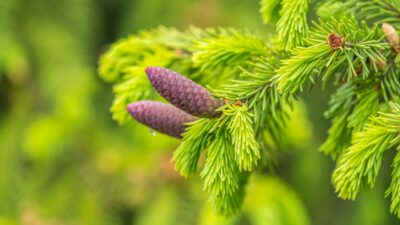
The Loves and Life of Beatrix Potter—Miss Potter, to Us


„Once upon a time there were four little Rabbits, and their names were—Flopsy, Mopsy, Cotton-tail and Peter.“ Who doesn’t love that story from their childhood? Beatrix Potter, the world-famous author of more than 23 „Little Books,“ was inspired to write „The Tale of Peter Rabbit“ by the nature and landscape of the Lake District in England.
The Life of Beatrix Potter
But did you ever wonder just what life was really like for Beatrix Potter? What were the things she loved? For sure they were her illustrations—whether her characters or the fungi she drew; her fiancé Norman Warne; her Herdwick sheep; the Lake District itself; and the properties she wanted kept for posterity and that became part of the National Trust. You can learn more about all of these in the upcoming movie „Miss Potter.“ Academy Award-winner Renee Zellweger plays the passionate and imaginative Beatrix Potter with Ewan McGregor capturing her heart as her publisher and true love, Norman Warne. The surprise is the movie is a love story, not what you’d think of when you consider those adorable characters and the woman who created them. „Miss Potter“ will be released in U.S. theaters this winter. And if you happen to be in the Lake District in the north of England, you can visit several of the places where the movie was made and where Beatrix Potter herself lived over the years. The Lake District is an area in the north of England where you’ll see the subtle hues of rolling pastures, quaint villages, and hardy stone walls. You’ll even smell the earthy aroma of burning peat as it fills the air and be transported to a bygone era—an era that inspired Ms. Potter. „I cannot rest, I must draw, however poor the result, and when I have a bad time come over me, it is a stronger desire than ever,“ wrote Beatrix in her journal. The Lake District was in her heart, and drawing and writing were in her blood, even from an early age.
Life’s Inspirations
Typical of young girls of her era, Beatrix Potter had little contact with her parents. Instead she had a governess for company and the governess’s children, whom she grew fond of. She once wanted to write to the son of one of them, Noel, but she wasn’t sure what to say, so she sent him a story. „My dear Noel, I don’t know what to write to you so I shall tell you a story about four little rabbits … Their names were Flopsy, Mopsy, Cotton-tail and Peter.“ She later had the idea of turning the rabbit story into a book and borrowed the letter back from Noel and copied it out. This story was to change her life. Today, more than 40 million copies of this book have been sold worldwide and in more than 35 languages. Although she made the Lake District her adopted home, Beatrix Potter was actually brought up in London, the daughter of a wealthy cotton family. The family would holiday in the Lake District and Beatrix Potter learned to draw here—not just those cute animals, but also fungi. In fact, many of her fungi illustrations are today in the British Guide to Fungi. Her first Lakeland summer holiday was spent at Wray Castle and this is where she met Canon Rawnsley, then vicar of Wray, who later became one of the founders of the National Trust. His ideas influenced Beatrix throughout her later life. It was Canon Rawnsley who suggested she get the little story about that cute rabbit called Peter published. These days the castle is not open to the public, but the grounds and arboretum are.
 The statue is the latest addition to the Enchanting World of Beatrix Potter and was unveiled by Renee Zellweger during the filming of the movie about the author’s life. (Sheila O’Connor)
The statue is the latest addition to the Enchanting World of Beatrix Potter and was unveiled by Renee Zellweger during the filming of the movie about the author’s life. (Sheila O’Connor)Another place the Potter family stayed during their long summers was Holehird and the gardens here are also open to the public free of charge. Check out the horticulture society garden. Beatrix‘ drawings of fungi were inspired by Holehird.
While her drawings of fungi and books were a success, unfortunately Miss Potter’s love life was not. It was in fact a rather sad one. She fell in love with Norman Warne but deliberated on whether to tell her parents (they felt he was unsuitable). She decided against telling them about their engagement. Tragically, Norman died only four weeks after the engagement and a grief-stricken Beatrix could do nothing but turn to her work. Two more of her „little books“ were created at this time: „The Tale of Tom Kitten“ and „The Tale of Jemima Puddle-Duck.“ In time she married a solicitor, William Heelis, but her first love was always Norman. Today William Heelis’s office houses a selection of Beatrix Potter’s original drawings and illustrations.
From Farms to Tea to National Treasure
Don’t forget to visit Yew Tree Farm. This farm is used in the movie „Miss Potter“ and was one farm Ms. Potter originally rented to tenants. The house was painted and 45 tons of topsoil was brought in for the movie’s vegetable patch. Today Yew Tree Farm is open to the public as a bed and breakfast and for lunches and teas. ( http://www.yewtreehouseandfarm.com )
And Beatrix Potter would have approved. In the 1930s, she encouraged her tenant farmers, including those at Yew Tree Farm, to supplement their income from farming by opening tea shops for Lake District visitors. Here you’ll also see some of the Lake District’s famous Herdwick sheep.
They are certainly easy to spot with brown bodies, white faces, and white legs. Beatrix Potter wanted these sheep to stay here and they were a personal favorite. The wool, however, does not do well commercially although the Herdwick meat is a local delicacy. The wool from the Herdwick sheep is good for blankets and carpets, but not much else. You’ll notice that there is a spinning gallery outside Yew Tree Farm where wool from the farm’s own sheep was spun. Although Yew Tree Farm is used in the film, it was actually in Hill Top, a delightful 17th century house, that Beatrix Potter lived and where she wrote many of her children’s stories. She was able to buy the property with the money she made from the sale of „The Tale of Peter Rabbit.“ Over the following years the house and surrounding countryside provided inspiration for her stories and illustrations. It was these stories that provided the revenue for her later farming activities and land purchases. When she died, she left Hill Top to the National Trust to open to the public on the condition that the house be kept, just as she left it, with all her belongings in place.
Her choice of the National Trust was a natural one when it came to finding a guardian for Hill Top and her other properties. The charity was very close to Ms. Potter’s heart. She was a great fan of natural beauty and, again, influenced by her friend, Canon Rawnsley, she bought up thousands of acres of land with the idea of leaving them to future generations in care of the National Trust. She donated over 4,000 acres of land to the Trust to keep it safe for future generations. Part of that donation was Tarn Hows, today one of the most visited sites in the Lake District for walking. When the area came up for sale in 1929, Beatrix Potter bought it and gave half to the National Trust. She bequeathed the other half to them in her will.
Visiting the Lake District
The Lake District is a great place to hike and soak in the atmosphere of Beatrix Potter’s life, but if all the literature and history makes you seek refreshment, then check out the Grasmere Gingerbread Shop. It was here that a certain Ms. Sarah Nelson invented a gingerbread recipe in the 1850s. So successful has that gingerbread been that the recipe is now kept in a bank vault! Ms. Nelson started selling her gingerbread at the age of 14 outside her house to visitors who came to visit the Wordsworth graves located right beside her home. ( www.grasmeregingerbread.co.uk ) Check it out and decide for yourself! Once you’ve had gingerbread, go visit the graves of the Wordsworth family in the cemetery next door.
 FARM OF LEGEND AND FILM: The Yew Tree Farm, one of several Ms. Potter rented out, was used in the filming of "Miss Potter." (Sheila O’Connor)
FARM OF LEGEND AND FILM: The Yew Tree Farm, one of several Ms. Potter rented out, was used in the filming of "Miss Potter." (Sheila O’Connor)Of course, you can’t be in the Lake District and not see some of those famous lakes, including Derwentwater, the „Queen of English lakes.“ Much of the filming of „Miss Potter“ took place here, and Derwentwater is featured in „Squirrel Nutkin,“ while nearby Newlands Valley is the setting for „Mrs. Tiggy-Winkle.“ One place Beatrix Potter would certainly have seen in her time was the Castlerigg Stone Circle, a mini „Stonehenge“ and one of Britain’s prehistoric monuments. The circle dates back to 3,000 B.C. and the 38 stones there weigh between 2.5 to 15 tons. Older than the druids, the area could have been used for religious worship, an astronomical observatory, or a meeting place. As you travel the Lake District you’ll certainly notice the stone walls that abound. They almost look like they could topple over but, rest assured, they won’t. There are 40,000 miles of such stone walls in the area and each one is different. No mortar is ever used and a good wall can actually last 200 years and longer. To take in as much of the beauty of the Lake District as possible, and to save time, take a van tour of the area. These can be provided by Mountain Goat, a company that began in 1972. ( www.mountain-goat.com )
One attraction of the Lake District you should definitely see is the World of Beatrix Potter. See the characters from her 23 stories come to life in beautiful 3-D settings. Check out Mrs. Tiggy-Winkle’s kitchen, the most popular attraction in the exhibit. Kids of all ages will enjoy having their photo taken here. The latest addition to the building is a bronze outdoor sculpture called „The Enchanting World of Beatrix Potter,“ which Renee Zellweger unveiled during filming. The statue has three children on the top releasing the figure of Jemima Puddle-duck, in recognition of the inspiration Beatrix Potter has given to children across the globe. Stuck for models, the sculptor, Anthony Bennett asked his twin seven-year-old sons and the daughter of the attraction’s director to do the honors!
Leaving a Legacy
Beatrix Potter died in 1943 at the age of 76, leaving her beloved Lake District behind. She might be gone, but her legacy—in the form of her books and her 1,619 hectares of land and 14 farms given over to the National Trust—lives on forever.
„If I have done anything—even a little—to help small children on the road to enjoy and appreciate honest, simple pleasures, I have done a bit of good,“ said Beatrix Potter.
You’ve done a lot of good, Miss Potter. Children everywhere, and of every age, will never forget you.
(The Epoch Times)





























vielen Dank, dass Sie unseren Kommentar-Bereich nutzen.
Bitte verzichten Sie auf Unterstellungen, Schimpfworte, aggressive Formulierungen und Werbe-Links. Solche Kommentare werden wir nicht veröffentlichen. Dies umfasst ebenso abschweifende Kommentare, die keinen konkreten Bezug zum jeweiligen Artikel haben. Viele Kommentare waren bisher schon anregend und auf die Themen bezogen. Wir bitten Sie um eine Qualität, die den Artikeln entspricht, so haben wir alle etwas davon.
Da wir die Verantwortung für jeden veröffentlichten Kommentar tragen, geben wir Kommentare erst nach einer Prüfung frei. Je nach Aufkommen kann es deswegen zu zeitlichen Verzögerungen kommen.
Ihre Epoch Times - Redaktion